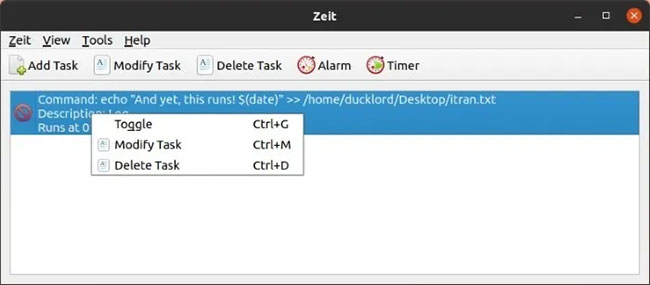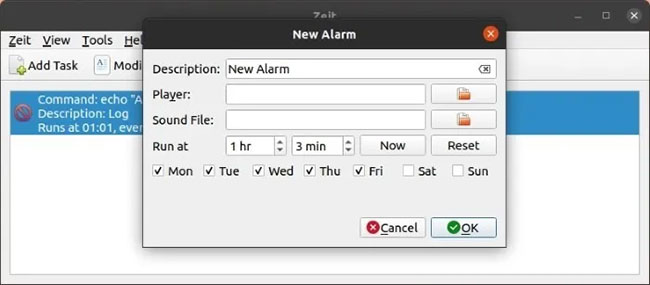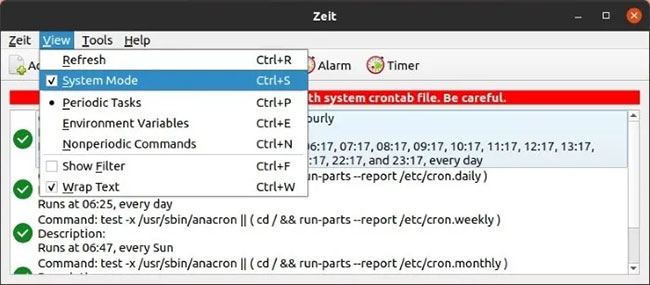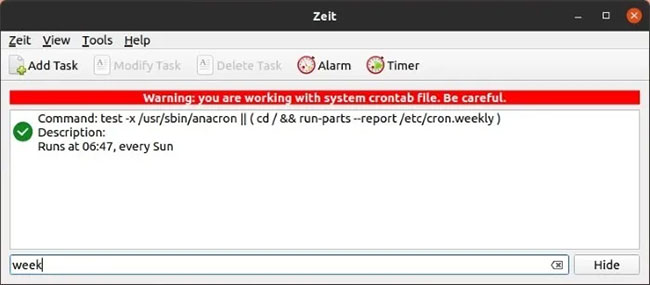How to create Cron Jobs in Linux with Zeit
Cron allows you to run commands, programs, and scripts automatically at specified times on time or on a schedule. It is powerful, lightweight, but makes you a little "brain twisted". That's why you can find front-ends trying to simplify using crontab and Zeit is one of the best options.
Let's see how Zeit allows you to easily create cron jobs in Linux easily through the following article!
Install Zeit
On most Linux distributions, you will have to build Zeit from source. Once downloaded and according to the official documentation, you can turn it into a usable app with:
mkdir build && cd build cmake . make -j2 ./src/zeitIf you're using Ubuntu, you can add its repository and install Zeit using the following commands:
sudo add-apt-repository ppa:blaze/main sudo apt update sudo apt install zeitAfter a while, you will find Zeit among installed programs. Locate and run the application.

Tasks and schedules
Zeit's interface is very simple. To add a task, click the 'Add Task' button .
Enter a name for the task in the Description field . Enter the command you want to schedule in the Command field .
In the 'Time and Date' section you can choose Basic , which allows you to quickly schedule a task to run in a regular pattern. For more customization, select the Advanced option .
The Advanced option allows you to enter the exact minutes, hour, day, day of the week, and month that the task will run. All fields are initially filled out with an asterisk, acting as a wildcard meaning 'every'. For example, if you enter '*' in the Day field , it means 'every day'.

You can enter multiple numbers, separate them with commas. For example, if you enter '20, 23 ' in the Hour field and ' 35 ' in the Minute field , your task will run at 20:35 and 23:35 every day.
If you want a prompt for crontab's syntax, hover your mouse over one of the fields. Zeit will show you a helpful pop-up with a list of examples of how you can set up the task's schedule.
 List of examples of how you can set up a task's schedule
List of examples of how you can set up a task's schedule
After you have created a task, it will appear in the main Zeit list. If you want to disable a quick task, you can double-click on it, while right-clicking will also allow you to edit or delete the task entirely.
Alarm and timer
Zeit allows you to set alarms and timers, but I won't go into detail on how to do that, as it's even simpler than tasks. With the alarm and timer feature, you don't have to worry about complicated wildcard characters and schedules, because even if it is useful for some people, this function is not provided.

You can simply set a simple schedule, specify times, and choose the days when the alarm or timer will run. Two extra buttons allow you to enter the current time in the Hour and Minutes fields (the Now button ) or delete them (the Reset button ). You must use the two buttons with the folder icon, next to Player and Sound File , to select the media player and sound file when setting the alarm and timer. Since Zeit / crontab will have no way to notify you without them. Zeit also won't let you set rules if you leave those fields blank.
Control everything
With Zeit, you're editing your own crontab rules by default, which only works for your user account. To see all the rules (by others and the system), as well as being able to edit everything, turn on 'System Mode' from the View menu .

With System Mode , you will be able to adjust the existing rules - for example, for the automated reports Ubuntu generates for the operating system. Be very careful when adjusting such rules, and be aware that any change you make could break everything. Edits may also be overwritten after a software update.
Filter and find
If you're trying to find a specific rule, you can use Zeit's search feature, instead of scrolling up and down the list. Press Ctrl + F on your keyboard and a search field will appear at the bottom of the Zeit window. Enter a search term to find the task you want.

You should read it
- Set up automatic mode in Linux with Crontab
- How to backup files on Linux to Google Drive
- How to create USB Boot Live Kali Linux
- How to quickly create new blank text files on Windows, Mac and Linux
- How to create new files in Linux
- How to Create Your Own Linux Distribution Using Yocto
- How to create a Live CD Linux disc
- How to create a new systemd service on Linux
May be interested
- How to create a Live CD Linux disc
 a live cd is a bootable cd, dvd or usb drive with an operating system ready to run when the disc is inserted into the computer. this article will show you how to create a linux live cd.
a live cd is a bootable cd, dvd or usb drive with an operating system ready to run when the disc is inserted into the computer. this article will show you how to create a linux live cd. - Create your own Linux distribution with Ubuntu Imager
 have you ever wanted to create your own linux distribution but don't know where to start? it's easier than you think. distroshare ubuntu imager creates a live iso that can be installed from an ubuntu or derivative distribution.
have you ever wanted to create your own linux distribution but don't know where to start? it's easier than you think. distroshare ubuntu imager creates a live iso that can be installed from an ubuntu or derivative distribution. - The way that Steve Jobs created 'unlimited warriors' who do bosses must know
 he knew that low goal means to accept mediocre results. but targeting high, if everything goes smoothly, it will create something extraordinary.
he knew that low goal means to accept mediocre results. but targeting high, if everything goes smoothly, it will create something extraordinary. - The moment of Steve Jobs's rare humor
 as a hot and stern celebrity, but also very humorous, steve jobs knows how to get the opposite person to concentrate so he can listen to him, but he knows how to make jokes to create laughter.
as a hot and stern celebrity, but also very humorous, steve jobs knows how to get the opposite person to concentrate so he can listen to him, but he knows how to make jokes to create laughter. - 8 easy tools to create your own Linux Distro
 you want to create your own distribution but don't know where to start and what tools to use, so read this article to learn about distro-creating tools yourself!
you want to create your own distribution but don't know where to start and what tools to use, so read this article to learn about distro-creating tools yourself! - Create bootable USB with Linux Mint 19.3
 in today's article, tipsmake.com will show you how to upgrade from the latest linux mint 17.3 to the existing linux mint 19.3. here is a step by step guide to doing this!
in today's article, tipsmake.com will show you how to upgrade from the latest linux mint 17.3 to the existing linux mint 19.3. here is a step by step guide to doing this! - 3 ways to try Linux without using USB
 many people think that the only way to experience linux on a computer is to create a bootable usb. in fact, there are simpler methods to try a linux distribution (distro) without booting from usb.
many people think that the only way to experience linux on a computer is to create a bootable usb. in fact, there are simpler methods to try a linux distribution (distro) without booting from usb. - How to create a Linux Bootable USB drive
 suppose you want to create usb bootable linux to boot and access on another computer but don't know how to do it. please refer to tipsmake's article below to learn how to create a linux bootable usb drive.
suppose you want to create usb bootable linux to boot and access on another computer but don't know how to do it. please refer to tipsmake's article below to learn how to create a linux bootable usb drive. - How to create SSH key on Linux
 ssh keys allow you to keep your remote server accounts secure while providing password-free access. it's easy to generate an ssh key on linux.
ssh keys allow you to keep your remote server accounts secure while providing password-free access. it's easy to generate an ssh key on linux. - How to create dual boot Linux and Windows 10 on Linux
 many people think that creating dual boot is easy for operating systems like linux mint or ubuntu, where everything is handled in the installation tool. the fact that this setup can easily be implemented on most versions of the linux operating system on the market using a simple tool. you can create dual boot linux and windows 10 regardless of which linux operating system you are running.
many people think that creating dual boot is easy for operating systems like linux mint or ubuntu, where everything is handled in the installation tool. the fact that this setup can easily be implemented on most versions of the linux operating system on the market using a simple tool. you can create dual boot linux and windows 10 regardless of which linux operating system you are running.










 Instructions for using find command in Linux
Instructions for using find command in Linux How to find broken symlinks in Linux
How to find broken symlinks in Linux How to install MySQL on Ubuntu 20.04
How to install MySQL on Ubuntu 20.04 How to run Android on Linux using a virtual machine
How to run Android on Linux using a virtual machine How to mount a Linux file system using WSL2 on Windows 10
How to mount a Linux file system using WSL2 on Windows 10 How to fix Checksum with the fsck command in Linux
How to fix Checksum with the fsck command in Linux